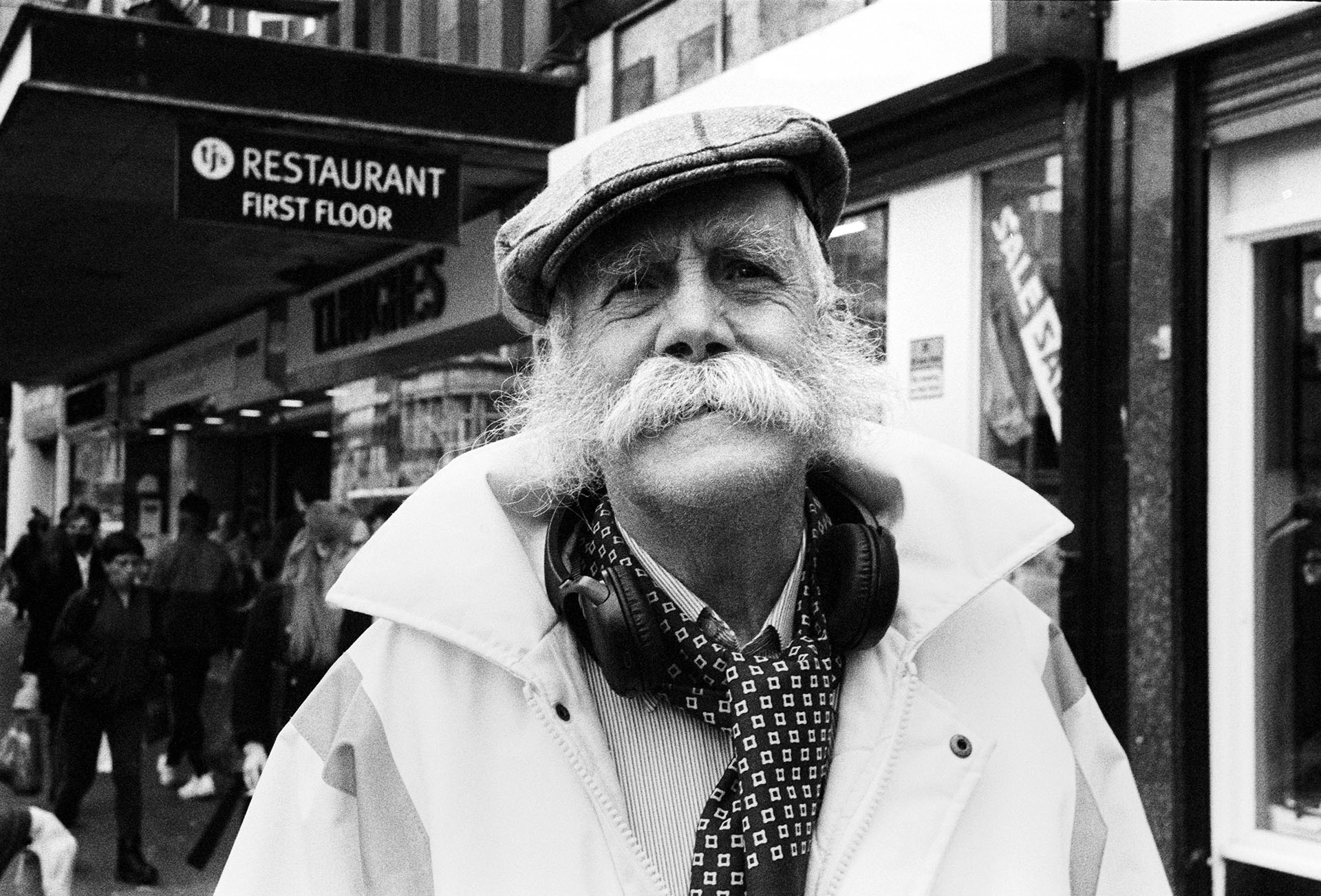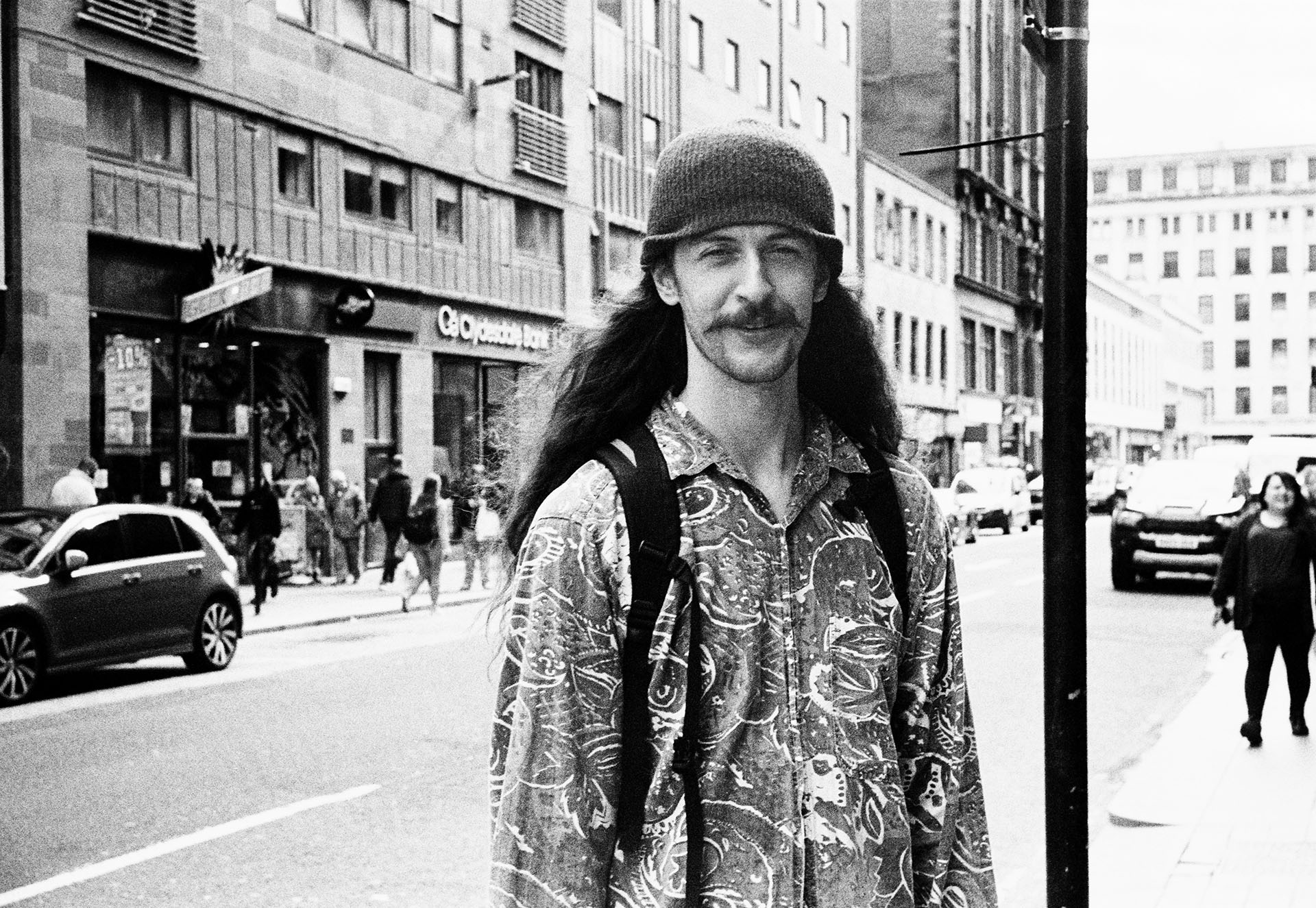Taking street photos while abroad has always been much easier for me than doing so at home. When travelling you can lean into the fact that you are a visitor – an unabashed tourist with a camera who can get away with more than they might in their own city. That seemed especially true coming from a place like Glasgow, where people aren’t shy about pulling you up if they think you are doing something suspect.
This year I wanted to get over my fear, and started working on a Glasgow street project. However, despite being a decent size, Glasgow doesn’t have too many densely packed urban areas where you can blend in. It wasn’t long before I was bored of trudging the same old paths and getting the same old pictures… so I decided to throw caution to the wind and do something that had always terrified me; ask strangers if I could take their portraits.
I am still a relative n00b at this, and still have a lot to learn, but here are some of my observations so far:
It is terrifying… but gets easier (kind of)
Asking strangers for their picture is something that almost every photography site or book recommends as a project, and it is one that I have always stubbornly resisted. Why subject yourself to crippling bouts of fear for a picture, when there’s so much else to take photos of? Well, it turns out that I ran out of things that inspired me… so much so that I decided to chance it.
There’s no getting away from the fact that approaching folks on the street is pretty terrifying. You feel like you are doing something weird or nefarious. However, the reality is that most people don’t care at all, or will even be flattered.
It does get slightly easier once you’ve done it a few times, but truth be told I still have a huge pit in my stomach when I first go out shooting, and only ask a few people a day. I’m not sure I would want that feeling to disappear entirely, as it’s the initial reservation that then leads to a rush of adrenaline when you have a pleasant interaction, and make a connection with a stranger. In fact, a key to shooting street portraits is to ride that wave and help it spur you on. My experience has been that once I’ve gotten over the initial hump with one successful picture, it has led to a string of others, as the hesitation from my internal narrative fades away. Rather than run away from the feelings, use them to your advantage.
One thing that can help manage the fear initially is to carry business cards which identify you as a photographer. This lends some kind of legitimacy to what you’re doing if anybody asks what the pictures are for, but it can also simply give you an extra bit of confidence. I do carry cards with my site and Instagram details, but in practice I rarely have to hand any out, as most folk aren’t even all that bothered.
Be approachable
If you want people to talk to you, you’re going to have to be aware of how you come across. If you seem twitchy and nervous, that energy is going to be projected, and any interactions you have will be much more strained. If you are relaxed and friendly, the opposite is much more likely to be true.
One of the mistakes I made initially was to wear sunglasses when I was out taking street portraits. I have sensitive eyes, and so did so out of a force of habit, but didn’t really appreciate that it made it harder for folk to trust me from the get go. As soon as I took them off and switched to my regular glasses, I had much more luck.
Another thing that I’ve found is that on the days where I ‘look’ a bit more creative, or like what people expect a typical hipster/art school student to be like, then I have much more luck – perhaps because it makes much more sense for someone like that to be out with an old camera doing something slightly eccentric than it might if I was wearing trackies. It’s a similar principle to embracing people’s perception of you as a tourist when taking regular street photography, leaning into a pre-conceived notion they might have which will mean they just treat you as a regular part of the scenery.
You don’t need to capture everything
When I first started taking street portraits, I was dismayed that I could come away with a full six hour day of shooting with only a handful of pictures. Everywhere I looked, it seemed like the streets were full of people that I should be asking but was too chicken to do so. It meant that the whole process felt more like an exercise in futility and inadequacy rather than a liberating one.
However, that changed after I realised something important: I didn’t need to ask everybody. Not only because not everybody would really want their picture taken anyway, but also because the pictures would be far more engaging if I was being more deliberate about who I asked. With this fresh perspective, it no longer felt like every single person that passed by was a missed opportunity – but that I was consciously seeking out those folks who had something about them in the crowds, and to catpure that. This was something that I later discovered was similar to the approach that Bruce Gilden would take to street portraits – where he would only ask a few people per day.
Coming away with just a few portraits each time still felt like a fairly limited return for the amount of time spent traversing the city, but when I compared it to the number of quality shots I would get from portrait sessions or regular street photography outings, the results were far more satisfying.
An hour can be enough
This is something that I have to constantly remind myself, as it goes against my instincts… but you don’t need to schedule a full day’s shooting to get good pictures. In fact, sometimes setting a tight time-frame can push you to get more shots than you might otherwise. Arriving into town an hour early before meeting a pal is no longer time that you need to kill, but a window of opportunity to take photos. The streets are always there, so getting out doesn’t have to be an ‘event’ – it’s just a matter of taking the opportunities that you have.
Ask first, explain later
When I first started approaching strangers, I felt like I had to justify why I was stopping them immediately, so they didn’t think I was a freak. I would launch into a whole explanation about how I was working on a photography project capturing people in Glasgow… blah blah… before asking them if I could take their photo. Nobody said yes. After building up the courage to speak to people, getting a string of knock backs was a real blow. I kept getting the same result until I got fed up and just flat-out asked someone if I could take their picture. To my surprise, they agreed.
What I realised was this: If you are approaching someone in the street, you need to make it clear immediately why you’re stopping them and what you want them to do. People will naturally often be on the defensive when approached by a stranger in public, and an elongated, up-front justification can seem like you are really just over-compensating for something.
Make a connection
When approaching someone now, I will come straight out and ask if I can take their picture. If they pause for a second before answering, I’ll let them know what in particular I noticed about them in the first place – whether that’s their hair, their hat, their glasses, a particularly fine beard, or whatever else it might be.
There are a number of photography sites which suggest this as some kind of cynical ploy to getting pictures easier. However, for me that it’s about helping establish some kind of genuine connection with another human being pretty quickly – something which is especially important when you are asking them to give up something quite person in return (a photograph). I realised this dilemma fairly early on when I started working in nightclubs: if you just sail through and take pictures of folk without any real interaction, you can see that lack of personality in the results. Some kind of level of engagement is needed if you are going to get a good portrait. Just making something up for the sake of it is not just disingenuous, but it’s often really obvious. Don’t do it.
Don’t rush off
Related to the above, when somebody does say yes, the temptation can well be to thank them and rush off as soon as possible. This has to be resisted.
I suspect that part of this urge to move on is simply down to a lack of confidence; a fear that folks will somehow realise that you’ve tricked them into participating into something nefarious. Maybe they’ll ask questions about what you’re using the pictures for, and discover that you’re just some amateur who doesn’t know what they’re doing. It could also be down to a kind of embarassment, as taking somebody’s picture – especially in a public place – is a strangely personal process.
The thing is though, you’re not doing anything especially odd (well, not that I know of, anyway), and if you internalise that, then you can begin to really appreciate and enjoy the interactions you have. Far too often when taking street photographs I’ve felt like some kind of observer/stalker figure, separate from what’s going on. With street portraits, you begin to be part of the performance of the street, involved with its people and all of the different things that make it so interesting.






This post resonated with me on a lot of levels. Having a purpose for taking strangers photos has always instilled confidence in me. I spent many years as a photojournalist and shoot first, ask questions later was always the best way. Usually, people would hear newspaper and they’d smile and strike up a conversation. Since moving to Denver to cover the tech scene, I haven’t had that purpose. My expeditions out to shoot street portraits have always given me that same pit in my stomach.
Hopefully, by embracing some of your advice here, I’ll get back in the swing of it. I guess it’s time to order some business cards. – Tobias
Thanks Tobias! I hear you on the purpose front. I’ve shot in nightclubs, festivals, parties, and all sorts of other events for years, and have no real issue with taking people’s pictures when I have that ‘designated’ function. Hell, even sometimes when I don’t… but in the street it is unexpected. You don’t have that veneer or cloak of legitimacy that comes implicitly with the other situations. Like you mentioned, that changes the dynamic entirely. p.s. Denver? My other half comes from there.
This is great advice as I often struggle asking strangers for their portrait, even though I know I’m not doing anything wrong. Approaching strangers on the street is terrifying, but I enjoy interacting with people so I try to ask someone every time I go out. Although, I tend to get rusty when I haven’t asked someone for a while!
I get rusty as well! I was just getting okay at it when the second lockdown happened too…
These are the exact things I discovered while living in Korea. 🥰
Thanks Cassi! I’d love to visit Korea sometime.
lovely, this really makes me want to take more black and whites
Thanks Russell!